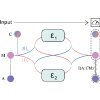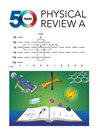Demonstration of superior communication through thermodynamically free channels in an optical quantum switch
IF 2.9
2区 物理与天体物理
Q2 Physics and Astronomy
引用次数: 0
Abstract
The release of the causal structure of physical events from a well-defined order to an indefinite order stimulates remarkable enhancements in various quantum information tasks. Some of these advantages, however, are questioned for the ambiguous role of the control system in the quantum switch, which is an experimentally realized process with an indefinite causal structure. In communications, for example, not only the superposition of alternative causal orders, but also the superposition of alternative trajectories can accelerate information transmissions. Here, we follow the proposal of Liu et al. [Phys. Rev. Lett. 129, 230604 (2022)], and examine the information enhancement effect of indefinite causal orders with the toolkit of thermodynamics in a photonic platform. Specifically, we simulate the thermal interaction between a system qubit and two heat baths embedded in a quantum switch by implementing the corresponding switched thermal channels. Although its action on the system qubit only is thermally free, our results suggest that the quantum switch should be seen as a resource when the control qubit is also considered. Moreover, we characterize the non-Markovian property in this scenario by measuring the information backflows from the heat baths to the system qubit.

通过光量子开关中的热力学自由通道演示卓越通信
物理事件的因果结构从定义明确的顺序变为不确定的顺序,激发了各种量子信息任务的显著提升。然而,由于量子开关中控制系统的作用不明确,其中一些优势受到质疑,因为量子开关是一个实验实现的过程,具有不确定的因果结构。例如,在通信中,不仅替代因果顺序的叠加,而且替代轨迹的叠加都能加速信息传输。在此,我们按照刘等人的建议[Phys. Rev. Lett. 129, 230604 (2022)],在光子平台上利用热力学工具包研究了不定因果顺序的信息增强效应。具体来说,我们通过实现相应的开关热通道,模拟了系统量子比特与嵌入量子开关的两个热浴之间的热相互作用。虽然量子开关对系统量子比特的作用是热自由的,但我们的结果表明,当同时考虑控制量子比特时,量子开关应被视为一种资源。此外,我们还通过测量从热浴到系统量子位的信息回流,描述了这种情况下的非马尔可夫特性。
本文章由计算机程序翻译,如有差异,请以英文原文为准。
求助全文
约1分钟内获得全文
求助全文
来源期刊

Physical Review A
物理-光学
CiteScore
5.40
自引率
24.10%
发文量
0
审稿时长
2.2 months
期刊介绍:
Physical Review A (PRA) publishes important developments in the rapidly evolving areas of atomic, molecular, and optical (AMO) physics, quantum information, and related fundamental concepts.
PRA covers atomic, molecular, and optical physics, foundations of quantum mechanics, and quantum information, including:
-Fundamental concepts
-Quantum information
-Atomic and molecular structure and dynamics; high-precision measurement
-Atomic and molecular collisions and interactions
-Atomic and molecular processes in external fields, including interactions with strong fields and short pulses
-Matter waves and collective properties of cold atoms and molecules
-Quantum optics, physics of lasers, nonlinear optics, and classical optics
 求助内容:
求助内容: 应助结果提醒方式:
应助结果提醒方式:


